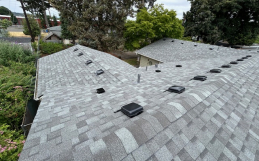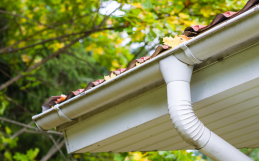(Updated August 2025)
A Guide for Building Owners Considering a Durable, Efficient Commercial Roofing System
Whether you’re replacing an aging roof or planning new construction, choosing the right roofing material can be a big decision—especially for commercial properties. One popular solution in today’s commercial roofing market is TPO roofing, a cost-effective and energy-efficient membrane designed to meet the demands of modern buildings.
Quick Answer: What Is TPO Roofing?
TPO (thermoplastic polyolefin) is a type of single-ply membrane roof used mainly on flat or low-slope commercial roofs. It’s made from a blend of rubber (ethylene propylene rubber) and various synthetic materials, forming a white, reflective membrane that’s heat-welded into place. Known for its energy efficiency, UV resistance, and cost effectiveness, TPO is widely used in new construction and roof replacements alike.
Understanding the TPO Roofing System
A TPO roofing membrane is part of a larger TPO roofing system designed to cover large flat areas efficiently. The system typically includes:
- The TPO membrane itself (often 45, 60, or 80 mils thick)
- Mechanical fasteners or adhesives to secure it to the roof deck
- Hot air welding at the seams to create a watertight surface
- Insulation boards underneath for added thermal performance
Unlike multi-layered roofing systems, TPO membranes offer protection in one layer—hence the term single ply roofing membrane.
What Are TPO Membranes Made Of?
TPO membranes are made from a thermoplastic polymer blend that includes:
- Polypropylene and ethylene-propylene rubber (for flexibility and durability)
- Fillers like talc or fiberglass
- UV stabilizers to protect against sunlight
- Reinforcing scrim to improve puncture resistance and strength
The result is a flexible, weather-resistant material that reflects sunlight, reduces heat buildup, and performs well in various climates.
Why Building Owners Choose TPO Roofing
 TPO roofing is among the fastest-growing options in the commercial roofing market—and for good reason. It checks many boxes for building owners looking to balance budget, performance, and long-term value.
TPO roofing is among the fastest-growing options in the commercial roofing market—and for good reason. It checks many boxes for building owners looking to balance budget, performance, and long-term value.
Key benefits include:
- Cost Effectiveness: TPO is less expensive than some other membrane roofs like PVC, while still offering great performance.
- Energy Efficiency: The bright white surface reflects UV rays, reducing cooling loads and potentially lowering utility bills.
- Durability: The heat welded seams create strong, watertight bonds that outperform glued seams over time.
- Compatibility: TPO can often be installed over existing roofing, making it a solid choice for retrofits.
Lifespan: How Long Does TPO Roofing Last?
Most TPO roofing membranes have a lifespan of 15 to 30 years, depending on the thickness of the material, climate, installation quality, and maintenance. Thicker membranes (like 80 mils) tend to last longer than thinner ones (like 45 mils), especially in high-traffic or extreme-weather areas.
Routine maintenance and inspections can help maximize the lifespan and catch small issues before they lead to leaks.
TPO Roofing vs. Other Flat Roofing Materials
When comparing TPO roofing to other roofing materials used on commercial roofs, here’s what to consider:
TPO vs. EPDM
EPDM is a rubber membrane often installed in large sheets. While it has a longer track record, EPDM is black and absorbs heat. TPO’s white surface provides better energy efficiency and UV protection. EPDM also relies on adhesive seams, whereas TPO is heat-welded for better performance.
TPO vs. PVC
PVC roofing membranes are chemically similar to TPO and also offer reflective surfaces and welded seams. PVC performs better in chemical-exposure environments (like restaurants), but is typically more expensive than TPO. For most general commercial uses, TPO roofing systems offer a great balance of cost and function.
TPO vs. Built-Up Roofing (BUR)
BUR systems are layered with asphalt and felt, offering durability but requiring longer installation times and higher costs. TPO is cleaner to install and better for modern energy codes.
What About Installation Over Existing Roofing?
One major advantage of TPO is that it can often be installed directly over existing roofing systems, reducing labor and disposal costs. This depends on the condition of the current roof and local code requirements, but it’s a valuable option for building owners looking to reduce disruption and save time.
Maintenance and Care for TPO Roofing
TPO roofs are relatively low-maintenance but do benefit from regular inspections—especially after storms or in areas with heavy foot traffic.
Basic care includes:
- Checking seams and flashings for wear
- Cleaning dirt or debris from the surface
- Inspecting for punctures or chemical spills
- Re-sealing any details around HVAC units or penetrations
Because the seams are heat-welded, they are stronger than glued seams but should still be checked annually to ensure long-term watertight protection.
Things to Consider Before Choosing TPO
 TPO is a versatile and reliable choice for many commercial roofing systems, but it’s not always the best fit for every situation. Here are a few things to weigh:
TPO is a versatile and reliable choice for many commercial roofing systems, but it’s not always the best fit for every situation. Here are a few things to weigh:
- Local climate: TPO’s reflective properties shine in warm, sunny areas.
- Building type: TPO is ideal for flat or low-slope commercial roofs, especially with rooftop HVAC systems.
- Chemical exposure: If the roof will be exposed to grease, oils, or harsh chemicals, PVC may be a better option.
- Contractor experience: Proper hot air welding is essential. Always choose a roofing contractor experienced in TPO installation.
FAQs About TPO Roofing
- What does TPO stand for in roofing?
TPO stands for thermoplastic polyolefin, a flexible, single-ply roofing membrane made from synthetic rubber and plastic blends.
- Is TPO roofing good for cold climates?
Yes. While known for reflecting UV rays, TPO also remains flexible in colder temperatures. However, snow and ice loads should be considered in structural planning.
- How is TPO roofing installed?
TPO membranes are either mechanically fastened or adhered to the roof deck, with seams fused using hot air welding to create strong, watertight bonds.
- Is TPO more affordable than other roofing materials?
TPO is considered one of the most cost-effective membrane roofing options, especially when factoring in its energy savings.
- Can TPO roofing be repaired if damaged?
Absolutely. Damaged areas can be cleaned and patched using compatible materials and heat welding, often without needing full replacement.
Trust Warner Roofing for Expert TPO Installation and Repair
At Warner Roofing & Construction, we bring decades of experience in commercial roofing solutions—including the installation and maintenance of TPO roofing systems. Our team uses the latest tools and techniques to ensure your TPO roof is installed with precision and built to last.
Whether you’re replacing an aging commercial roof, building a new facility, or evaluating roofing materials for energy upgrades, we’ll help you make an informed decision that fits your goals and budget.
Ready to explore the benefits of TPO for your commercial building? Contact Warner Roofing today for a free consultation and expert guidance.







